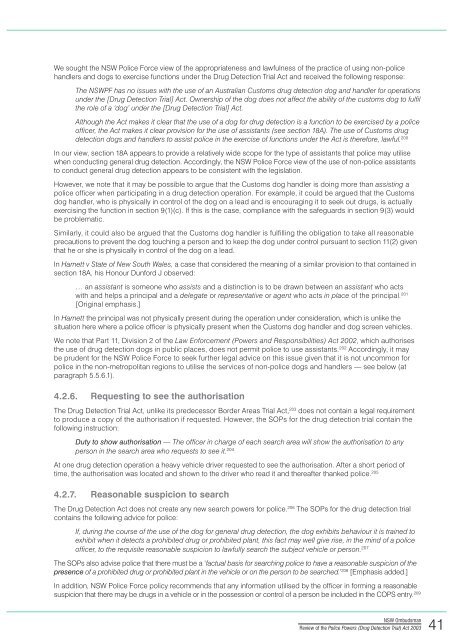Review of the Police Powers (Drug Detection Trial) Act 2003 - NSW ...
Review of the Police Powers (Drug Detection Trial) Act 2003 - NSW ...
Review of the Police Powers (Drug Detection Trial) Act 2003 - NSW ...
You also want an ePaper? Increase the reach of your titles
YUMPU automatically turns print PDFs into web optimized ePapers that Google loves.
We sought <strong>the</strong> <strong>NSW</strong> <strong>Police</strong> Force view <strong>of</strong> <strong>the</strong> appropriateness and lawfulness <strong>of</strong> <strong>the</strong> practice <strong>of</strong> using non-police<br />
handlers and dogs to exercise functions under <strong>the</strong> <strong>Drug</strong> <strong>Detection</strong> <strong>Trial</strong> <strong>Act</strong> and received <strong>the</strong> following response:<br />
The <strong>NSW</strong>PF has no issues with <strong>the</strong> use <strong>of</strong> an Australian Customs drug detection dog and handler for operations<br />
under <strong>the</strong> [<strong>Drug</strong> <strong>Detection</strong> <strong>Trial</strong>] <strong>Act</strong>. Ownership <strong>of</strong> <strong>the</strong> dog does not affect <strong>the</strong> ability <strong>of</strong> <strong>the</strong> customs dog to fulfil<br />
<strong>the</strong> role <strong>of</strong> a ‘dog’ under <strong>the</strong> [<strong>Drug</strong> <strong>Detection</strong> <strong>Trial</strong>] <strong>Act</strong>.<br />
Although <strong>the</strong> <strong>Act</strong> makes it clear that <strong>the</strong> use <strong>of</strong> a dog for drug detection is a function to be exercised by a police<br />
<strong>of</strong>ficer, <strong>the</strong> <strong>Act</strong> makes it clear provision for <strong>the</strong> use <strong>of</strong> assistants (see section 18A). The use <strong>of</strong> Customs drug<br />
detection dogs and handlers to assist police in <strong>the</strong> exercise <strong>of</strong> functions under <strong>the</strong> <strong>Act</strong> is <strong>the</strong>refore, lawful. 200<br />
In our view, section 18A appears to provide a relatively wide scope for <strong>the</strong> type <strong>of</strong> assistants that police may utilise<br />
when conducting general drug detection. Accordingly, <strong>the</strong> <strong>NSW</strong> <strong>Police</strong> Force view <strong>of</strong> <strong>the</strong> use <strong>of</strong> non-police assistants<br />
to conduct general drug detection appears to be consistent with <strong>the</strong> legislation.<br />
However, we note that it may be possible to argue that <strong>the</strong> Customs dog handler is doing more than assisting a<br />
police <strong>of</strong>ficer when participating in a drug detection operation. For example, it could be argued that <strong>the</strong> Customs<br />
dog handler, who is physically in control <strong>of</strong> <strong>the</strong> dog on a lead and is encouraging it to seek out drugs, is actually<br />
exercising <strong>the</strong> function in section 9(1)(c). If this is <strong>the</strong> case, compliance with <strong>the</strong> safeguards in section 9(3) would<br />
be problematic.<br />
Similarly, it could also be argued that <strong>the</strong> Customs dog handler is fulfilling <strong>the</strong> obligation to take all reasonable<br />
precautions to prevent <strong>the</strong> dog touching a person and to keep <strong>the</strong> dog under control pursuant to section 11(2) given<br />
that he or she is physically in control <strong>of</strong> <strong>the</strong> dog on a lead.<br />
In Harnett v State <strong>of</strong> New South Wales, a case that considered <strong>the</strong> meaning <strong>of</strong> a similar provision to that contained in<br />
section 18A, his Honour Dunford J observed:<br />
… an assistant is someone who assists and a distinction is to be drawn between an assistant who acts<br />
with and helps a principal and a delegate or representative or agent who acts in place <strong>of</strong> <strong>the</strong> principal. 201<br />
[Original emphasis.]<br />
In Harnett <strong>the</strong> principal was not physically present during <strong>the</strong> operation under consideration, which is unlike <strong>the</strong><br />
situation here where a police <strong>of</strong>ficer is physically present when <strong>the</strong> Customs dog handler and dog screen vehicles.<br />
We note that Part 11, Division 2 <strong>of</strong> <strong>the</strong> Law Enforcement (<strong>Powers</strong> and Responsibilities) <strong>Act</strong> 2002, which authorises<br />
<strong>the</strong> use <strong>of</strong> drug detection dogs in public places, does not permit police to use assistants. 202 Accordingly, it may<br />
be prudent for <strong>the</strong> <strong>NSW</strong> <strong>Police</strong> Force to seek fur<strong>the</strong>r legal advice on this issue given that it is not uncommon for<br />
police in <strong>the</strong> non-metropolitan regions to utilise <strong>the</strong> services <strong>of</strong> non-police dogs and handlers — see below (at<br />
paragraph 5.5.6.1).<br />
4.2.6. Requesting to see <strong>the</strong> authorisation<br />
The <strong>Drug</strong> <strong>Detection</strong> <strong>Trial</strong> <strong>Act</strong>, unlike its predecessor Border Areas <strong>Trial</strong> <strong>Act</strong>, 203 does not contain a legal requirement<br />
to produce a copy <strong>of</strong> <strong>the</strong> authorisation if requested. However, <strong>the</strong> SOPs for <strong>the</strong> drug detection trial contain <strong>the</strong><br />
following instruction:<br />
Duty to show authorisation — The <strong>of</strong>ficer in charge <strong>of</strong> each search area will show <strong>the</strong> authorisation to any<br />
person in <strong>the</strong> search area who requests to see it. 204<br />
At one drug detection operation a heavy vehicle driver requested to see <strong>the</strong> authorisation. After a short period <strong>of</strong><br />
time, <strong>the</strong> authorisation was located and shown to <strong>the</strong> driver who read it and <strong>the</strong>reafter thanked police. 205<br />
4.2.7. Reasonable suspicion to search<br />
The <strong>Drug</strong> <strong>Detection</strong> <strong>Act</strong> does not create any new search powers for police. 206 The SOPs for <strong>the</strong> drug detection trial<br />
contains <strong>the</strong> following advice for police:<br />
If, during <strong>the</strong> course <strong>of</strong> <strong>the</strong> use <strong>of</strong> <strong>the</strong> dog for general drug detection, <strong>the</strong> dog exhibits behaviour it is trained to<br />
exhibit when it detects a prohibited drug or prohibited plant, this fact may well give rise, in <strong>the</strong> mind <strong>of</strong> a police<br />
<strong>of</strong>ficer, to <strong>the</strong> requisite reasonable suspicion to lawfully search <strong>the</strong> subject vehicle or person. 207<br />
The SOPs also advise police that <strong>the</strong>re must be a ‘factual basis for searching police to have a reasonable suspicion <strong>of</strong> <strong>the</strong><br />
presence <strong>of</strong> a prohibited drug or prohibited plant in <strong>the</strong> vehicle or on <strong>the</strong> person to be searched.’ 208 [Emphasis added.]<br />
In addition, <strong>NSW</strong> <strong>Police</strong> Force policy recommends that any information utilised by <strong>the</strong> <strong>of</strong>ficer in forming a reasonable<br />
suspicion that <strong>the</strong>re may be drugs in a vehicle or in <strong>the</strong> possession or control <strong>of</strong> a person be included in <strong>the</strong> COPS entry. 209<br />
<strong>NSW</strong> Ombudsman<br />
<strong>Review</strong> <strong>of</strong> <strong>the</strong> <strong>Police</strong> <strong>Powers</strong> (<strong>Drug</strong> <strong>Detection</strong> <strong>Trial</strong>) <strong>Act</strong> <strong>2003</strong><br />
41

















